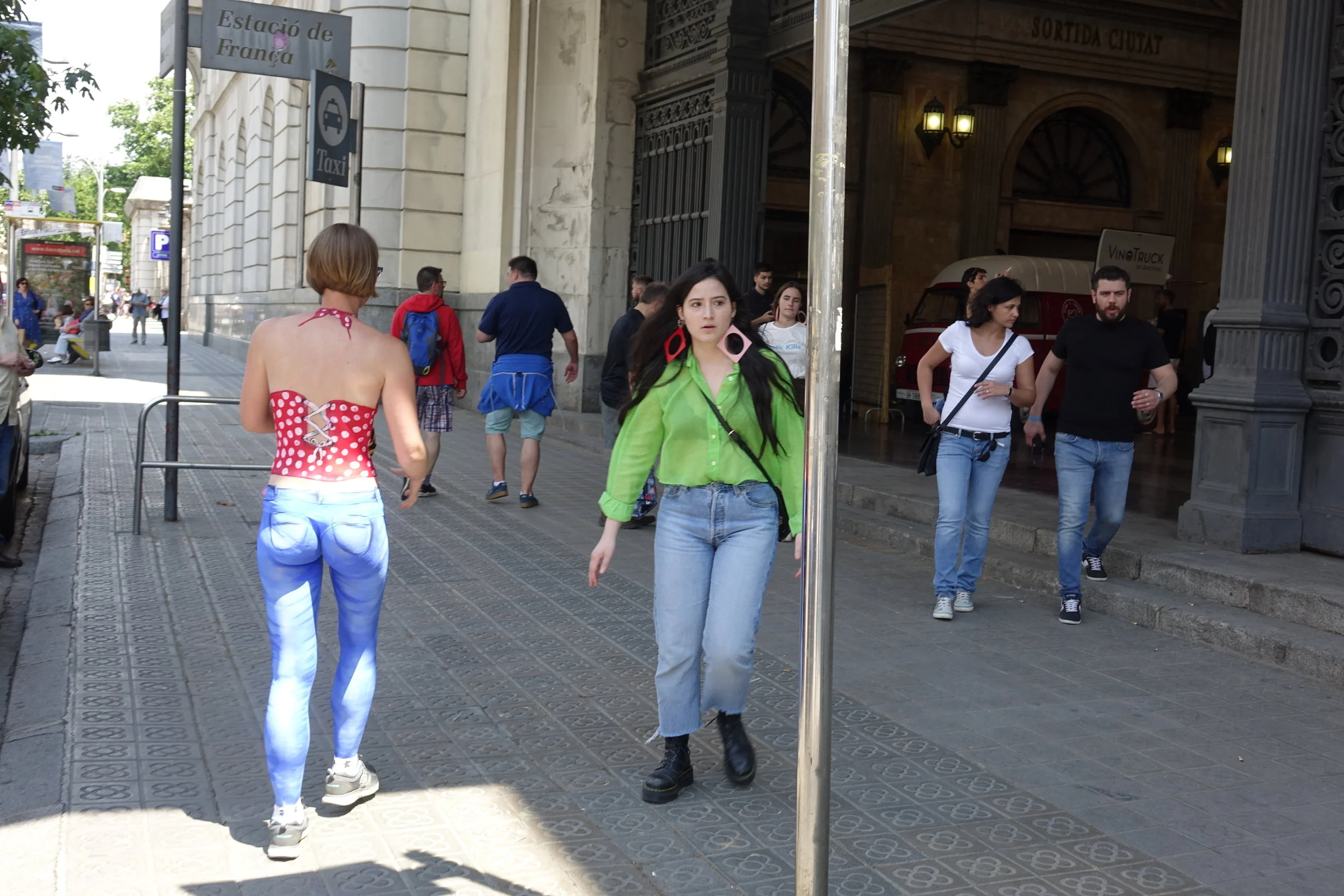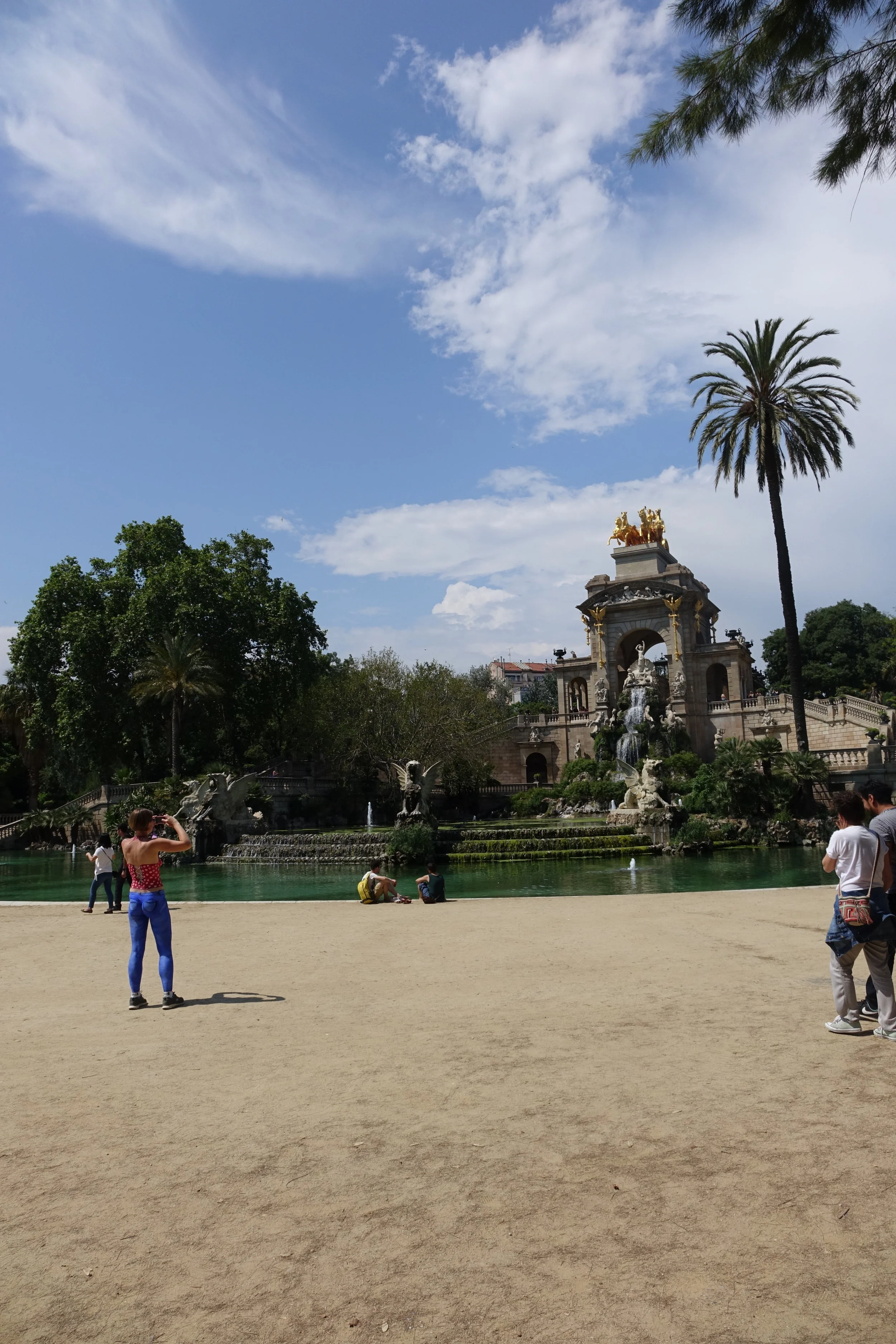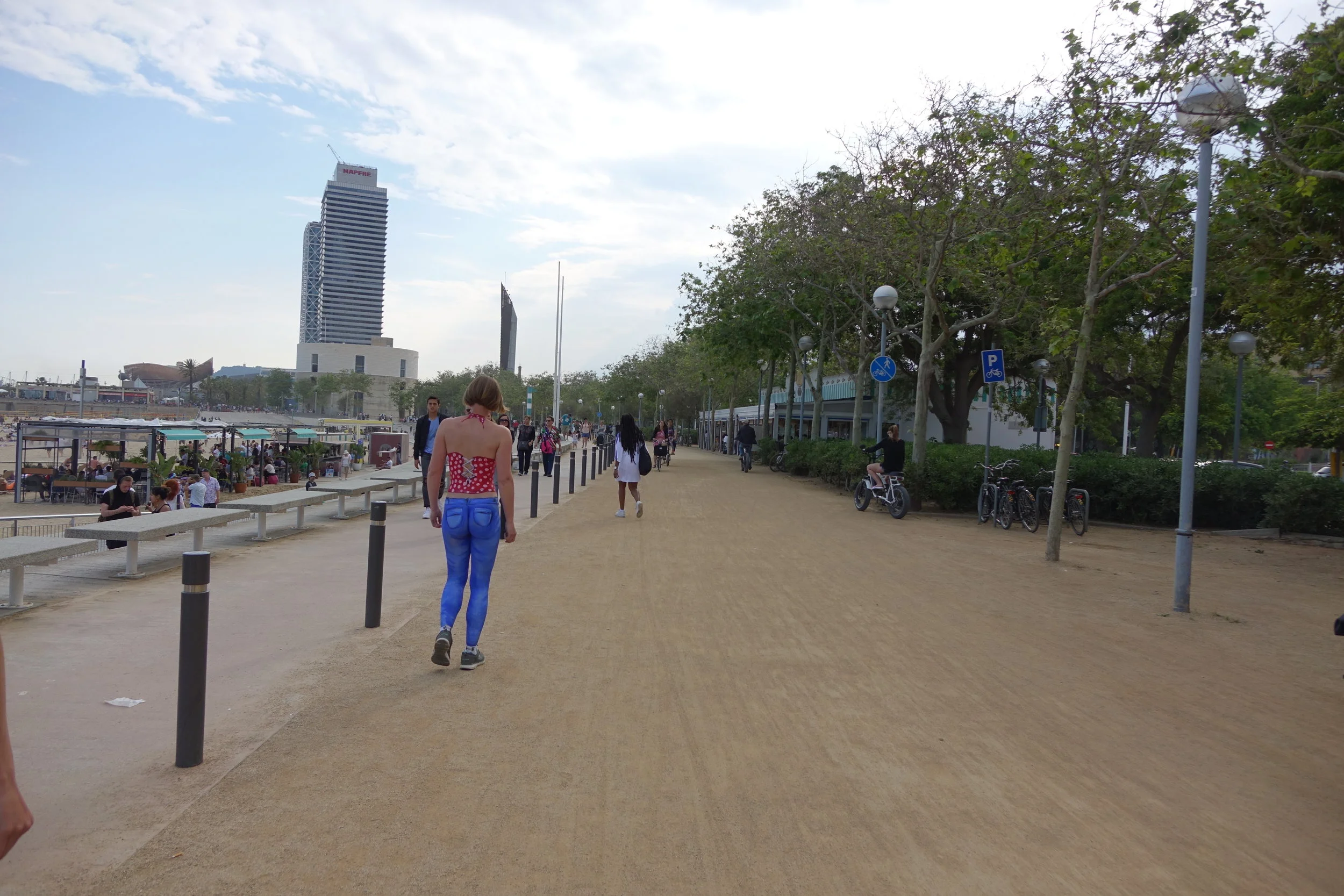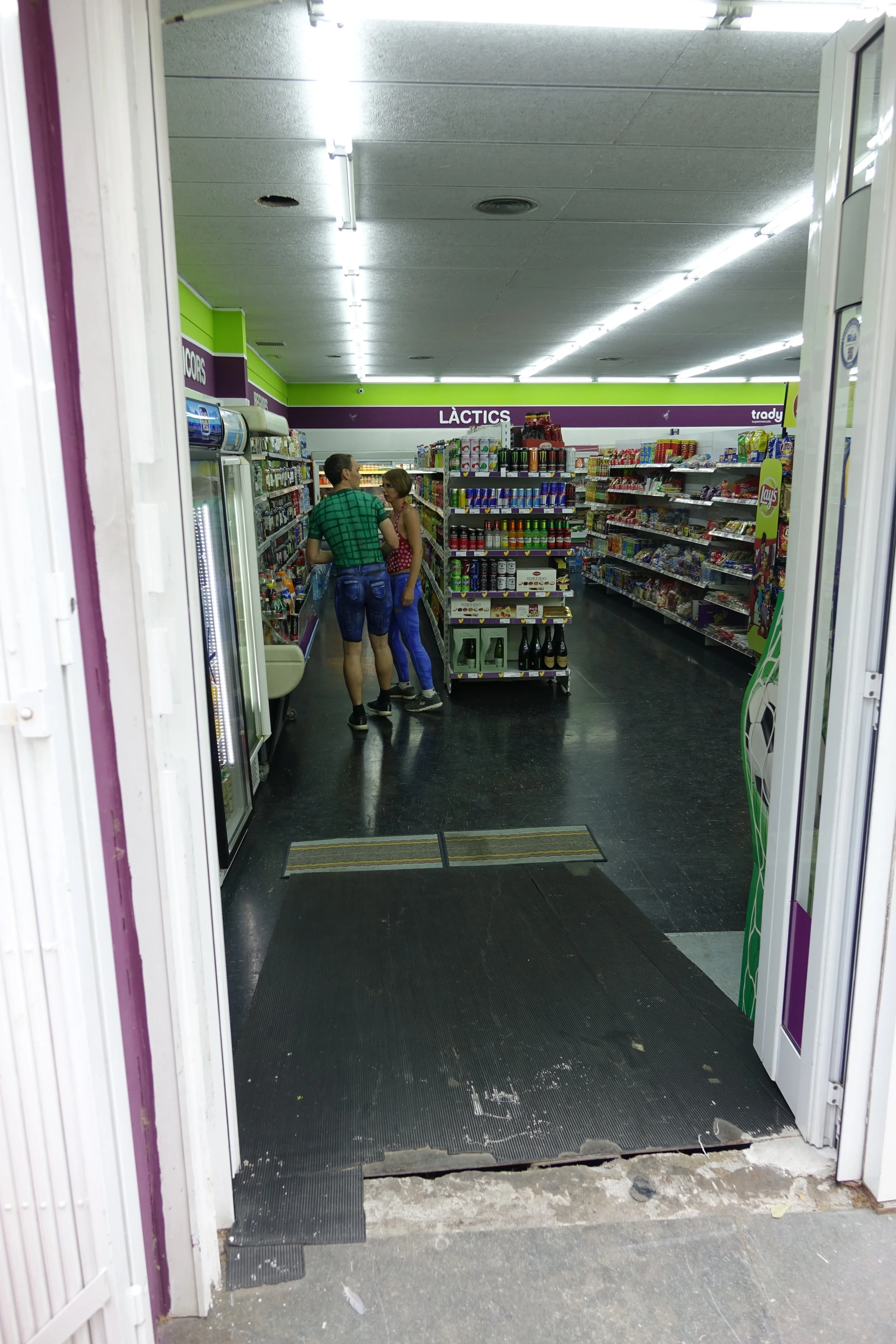
















Your Custom Text Here
Body painting courtesy of bodypaint barcelona
Performance
The models were body painted in fake clothes and spent over 2.5hrs on Barcelona’s streets and public transport. For the first part of the performance the models were wearing thongs and pasties, but these were removed halfway through (and the painting touched up).
Realisation
This was carried out in two parts. In the first part the performers retained their underwear and visited a public market (for which permission had been obtained), before walking 350m through a busy city centre location with high pedestrian and vehicle traffic to the metro, and then riding several stops to a quieter beach and residential area where they walked for around 1.5km. The route was then reversed, but with the underwear removed. The models completed these journeys separately with an observer following at a discreet distance watching reactions and carrying a spare set of clothes.
The performers also went out in the evening as a pair wearing just the body paint and visited three bars (for one we had permission, for one we asked upon entering and for one we just went in).
In general in was interesting how few people realised the performers were body painted. This was true even once the underwear was removed, although it did become more noticeable for the male model. This therefore gave an interesting insight into the ‘humanity bubble’; the normalcy of being completely wrapped up in ourselves and removing our attention from those around us.
Translators helped question the public about how they felt about the situation; and we conducted quick surveys to ask people if they felt ‘good’, ‘bad’ or ‘indifferent’ about the models. In all cases we received a ‘good’ response although when questioned further several people did comment that the ‘next stage’ (removing underwear when body painted with underwear, just being in underwear when body painted and nude, being fully nude when in underwear) would be strange and/or uncomfortable.
However, as we progressed down this path, both in this performance and other associated performances such as Brownfield, the public reaction did not change to the extent that people had implied it would when questioned. When asked about it in advance there was a perception that anything ‘more’ than the current situation would be weird, but that weirdness did not seem to arise even when we pushed it further. Why is it then that we have these preconceived notions that aren’t borne out in reality? Should ‘more’ be weird or is there media imaging and embedded cultural values that make us afraid of the unknown, afraid of change?
We did sometimes find a slightly adverse reaction upon trying to enter shops or cafes, although we were able to purchase items in both and did sit outside one café (nude in body paint) for over an hour, although in neither case was the experience particularly welcoming. The reaction seemed to stem from the desire for a person to “protect their castle”. The street was a public and unowned space so we were accepted there, but on entering a building we were sometimes seen as invaders that needed to be dealt with. Having now carried out our first performance of Society Cut-Out, it is interesting to look back on the body painting experience and question whether owners were less inviting of us out of a genuine distaste on their part, or as part of the circular loop we saw in Society Cut-Out of feeling the need to take action to protect others who weren’t offended, upset or uncomfortable.
When out for the night we had some really great conversations, and some very welcoming hosts, in all the bars we visited. Thank you to everyone who let us in, and to all the customers who spoke, danced and drank with us.
The Emperor’s New Clothes is probably the most enjoyable performance we have done to date. There was more interaction with the public and less risk of adverse police involvement (on the basis that the models would notice them before the police realised the models were nude). This is something we definitely want to try again and for a much more extended time period (i.e. all day).
Body painting courtesy of bodypaint barcelona
Performance
The models were body painted in fake clothes and spent over 2.5hrs on Barcelona’s streets and public transport. For the first part of the performance the models were wearing thongs and pasties, but these were removed halfway through (and the painting touched up).
Realisation
This was carried out in two parts. In the first part the performers retained their underwear and visited a public market (for which permission had been obtained), before walking 350m through a busy city centre location with high pedestrian and vehicle traffic to the metro, and then riding several stops to a quieter beach and residential area where they walked for around 1.5km. The route was then reversed, but with the underwear removed. The models completed these journeys separately with an observer following at a discreet distance watching reactions and carrying a spare set of clothes.
The performers also went out in the evening as a pair wearing just the body paint and visited three bars (for one we had permission, for one we asked upon entering and for one we just went in).
In general in was interesting how few people realised the performers were body painted. This was true even once the underwear was removed, although it did become more noticeable for the male model. This therefore gave an interesting insight into the ‘humanity bubble’; the normalcy of being completely wrapped up in ourselves and removing our attention from those around us.
Translators helped question the public about how they felt about the situation; and we conducted quick surveys to ask people if they felt ‘good’, ‘bad’ or ‘indifferent’ about the models. In all cases we received a ‘good’ response although when questioned further several people did comment that the ‘next stage’ (removing underwear when body painted with underwear, just being in underwear when body painted and nude, being fully nude when in underwear) would be strange and/or uncomfortable.
However, as we progressed down this path, both in this performance and other associated performances such as Brownfield, the public reaction did not change to the extent that people had implied it would when questioned. When asked about it in advance there was a perception that anything ‘more’ than the current situation would be weird, but that weirdness did not seem to arise even when we pushed it further. Why is it then that we have these preconceived notions that aren’t borne out in reality? Should ‘more’ be weird or is there media imaging and embedded cultural values that make us afraid of the unknown, afraid of change?
We did sometimes find a slightly adverse reaction upon trying to enter shops or cafes, although we were able to purchase items in both and did sit outside one café (nude in body paint) for over an hour, although in neither case was the experience particularly welcoming. The reaction seemed to stem from the desire for a person to “protect their castle”. The street was a public and unowned space so we were accepted there, but on entering a building we were sometimes seen as invaders that needed to be dealt with. Having now carried out our first performance of Society Cut-Out, it is interesting to look back on the body painting experience and question whether owners were less inviting of us out of a genuine distaste on their part, or as part of the circular loop we saw in Society Cut-Out of feeling the need to take action to protect others who weren’t offended, upset or uncomfortable.
When out for the night we had some really great conversations, and some very welcoming hosts, in all the bars we visited. Thank you to everyone who let us in, and to all the customers who spoke, danced and drank with us.
The Emperor’s New Clothes is probably the most enjoyable performance we have done to date. There was more interaction with the public and less risk of adverse police involvement (on the basis that the models would notice them before the police realised the models were nude). This is something we definitely want to try again and for a much more extended time period (i.e. all day).